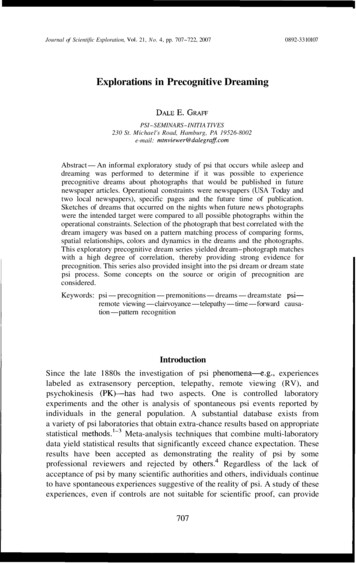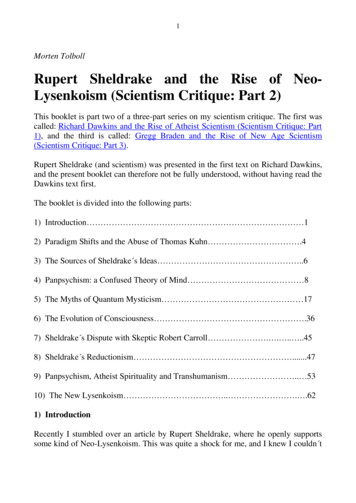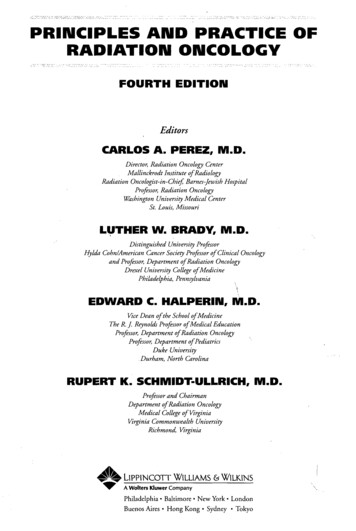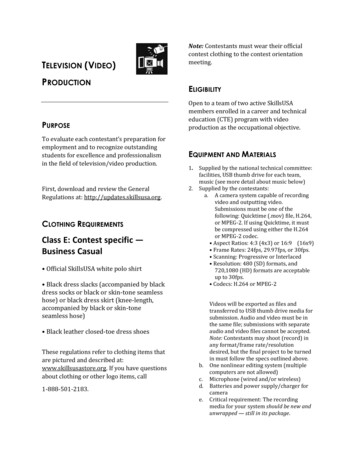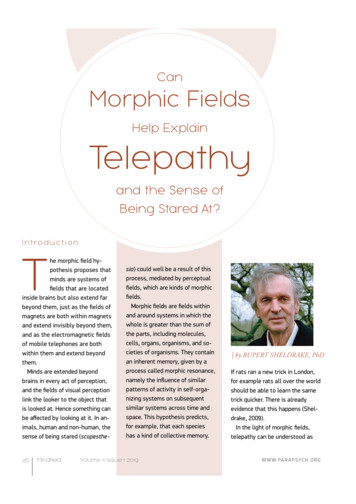
Transcription
CanMorphic FieldsHelp ExplainTelepathyand the Sense ofBeing Stared At?I nt ro d u c t i onThe morphic field hypothesis proposes thatminds are systems offields that are locatedinside brains but also extend farbeyond them, just as the fields ofmagnets are both within magnetsand extend invisibly beyond them,and as the electromagnetic fieldsof mobile telephones are bothwithin them and extend beyondthem.Minds are extended beyondbrains in every act of perception,and the fields of visual perceptionlink the looker to the object thatis looked at. Hence something canbe affected by looking at it. In animals, human and non-human, thesense of being stared (scopesthe-26Mindfieldsia) could well be a result of thisprocess, mediated by perceptualfields, which are kinds of morphicfields.Morphic fields are fields withinand around systems in which thewhole is greater than the sum ofthe parts, including molecules,cells, organs, organisms, and societies of organisms. They containan inherent memory, given by aprocess called morphic resonance,namely the influence of similarpatterns of activity in self-organizing systems on subsequentsimilar systems across time andspace. This hypothesis predicts,for example, that each specieshas a kind of collective memory.Volume 11 Issue 1 2019 by RUPERT SHELDRAKE, PhDIf rats ran a new trick in London,for example rats all over the worldshould be able to learn the sametrick quicker. There is alreadyevidence that this happens (Sheldrake, 2009).In the light of morphic fields,telepathy can be understood asW W W. PA R A P S YC H.ORG
Volume 11Issue 1 2019an interaction between membersof social groups within the morphic field of the group as a whole,which interconnects the individualanimals (Sheldrake, 2013).Morphic fields associated withspecific intentions could perhapshelp in understanding psychokinetic phenomena and remote viewing.But this hypothesis does not provide any immediate explanation forprecognition or presentiment.Intellectual history and ancestryFrom the 1964 to 1974, I did research on developmental biologyat Cambridge—in particular onthe development of plants. I alsoworked on plants growing underfield conditions at an InternationalAgricultural Research Institutein India from 1974 to 1985. Butneither my own work nor otherresearch in developmental biologygave an adequate explanation ofthe development of form. Chemicalsignals, gene activation, and othermolecular processes seemed inadequate. Something more was needed and I was drawn to the longestablished concept of morphogenetic fields, or form-shaping fields,first proposed in the 1920s. Thesefields shape the form of developingcells, tissues, organs and organisms. They are within and aroundthe system they are shaping.Although this concept is widelyused by developmental biologists,no one knows what morphogeneticWWW.PARAPSYC H . O R GCan Morphic Fields Help Explain Telepathyand the Sense of Being Stared At?fields are. Most researchers treatthem as a descriptive convenience,placeholders for fully mechanisticexplanations that have not yetbeen discovered. I find it morefruitful to think of them as realfields, of a similar degree of realityto magnetic fields, with their ownparticular properties. These includememories from previous systemsthat shape the fields themselves.This memory is given by morphicresonance, a connection frompast to present systems acrossspace and time on the basis ofsimilarity (Sheldrake, 2009). Thesefields work by drawing developingsystems towards attractors, asdescribed mathematically by theFrench mathematician René Thom(Thom, 1975).This hypothesis has many implications for the understanding ofbiological processes like proteinfolding, inheritance, collectivememory, learning, and memoryitself, which on this hypothesis depends on morphic resonance ratherthan on material traces storedwithin brains (Sheldrake, 2012).My interest in psi phenomenaarose in the 1980s when I realizedthat this hypothesis implies thatscopesthesia and telepathy shouldbe widespread in the animal kingdom. They are biological phenomena, natural, not supernatural, normal, not paranormal, and probablycommon to many animal species.B as i c p re m i sesand postulatesThe basic postulates of the hypothesis of formative causation,the overall name for the hypothesis of morphic fields and morphicresonance, are as follows:1. Self-organizing systems,including molecules, cells,tissues, organs, organisms,societies and minds are madeup of nested hierarchies (holarchies) of holons or morphicunits (Figure 1). At each levelthe whole is more than thesum of the parts, and theseparts themselves are wholesmade up of parts.Figure 1. A nested hierarchy or holarchy of morphic units, each organizedby a morphic field. These could be subatomic particles in atoms, molecules,and crystals. Or they could be cells,tissues, organs, organisms, and societies of organisms.Volume 11 Issue 1 2019Mindfield27
Can Morphic Fields Help Explain Telepathyand the Sense of Being Stared At?2. The wholeness of each leveldepends on an organizingfield, called a morphic field.This field is within and aroundthe system it organizes and isa vibratory pattern of activitythat interacts with electromagnetic and quantum fieldsof the system. The genericname morphic field includesa. Morphogenetic fields thatshape the development ofplants and animals.b. Perceptual and behavioral fields that organize theperceptions, movements,instincts and learned behavior of animals.c. Social fields that linktogether and coordinate thebehavior of social groupssuch as termite colonies,schools of fish, flocks ofbirds, packs or herds of animals, and human societies.d. Mental fields that underliemental activities and shapethe habits of minds.3. Morphic fields contain attractors (goals) and chreodes(habitual pathways towardsthose goals) that guide asystem toward its end statewhile maintaining its integrity,stabilizing it against disruptions.4. Morphic fields are shaped bymorphic resonance from allsimilar past systems, andthus contain a cumulative,28Mindfieldcollective memory. Morphic resonance depends onsimilarity and is not attenuated by distance in spaceor time. Morphic fields arelocal, within and around thesystems they organize, butmorphic resonance is non-local.5. Morphic resonance involves atransfer of form, or in-formation, rather than a transfer ofenergy.6. Morphic fields are fields ofprobability, like quantumfields, and they work by imposing patterns on otherwiserandom events in the systemsunder their influence.7. All self-organizing systemsare influenced by self-resonance from their own past,which plays an essential rolein maintaining a holon’s identity, continuity and memory(Sheldrake, 2009).This hypothesis leaves open thequestion of how morphic resonance actually works. There areseveral suggestions. One is thatthe transfer of information occursthrough the “implicate order,”as proposed by the quantumphysicist David Bohm (Sheldrake2009, Appendix B). The implicate or enfolded order gives riseto the world we can observe, theexplicate order, in which thingsare located in space and time. InVolume 11 Issue 1 2019T h e B u l l et i n of t h eP a ra p s y c h o l o g i ca lAssociationthe implicate order, according toBohm, “everything is enfolded intoeverything” (Bohm, 1980).Or resonance may pass throughthe quantum vacuum field, alsoknown as the zero-point energyfield, which mediates all quantumand electromagnetic processes(Laszlo, 2007).Or similar systems might beconnected through hidden extra dimensions (there are five instring theory and six in M-theory)(Carr, 2008). It’s also possiblethat morphic resonance dependson new kinds of physics as yetunthought-of.As applied to the sense of beingstared at (scopesthesia), morphicfield hypothesis implies that the effects on the subject being stared atdepend more on the focusing of attention and intention than on distance. For example, this sense maywork just as well over a distance ofhundreds of feet as over a few feetif the process of watching is aidedby telescopic lenses. It may alsowork through indirect means, as intelevision or closed circuit television (CCTV), although more weaklythan through direct vision, whichestablishes a more direct connection (Sheldrake, 2013).In relation to telepathy, thishypothesis suggests that telepathy will occur primarily betweenbonded members of social groupsrather than between strangers(Sheldrake, 2013).W W W. PA R A P S YC H.ORG
Volume 11Issue 1 2019Telepathy would beexpected to occurmost effectivelybetween people whoare strongly bondedemotionally, likemothers and babies,twins, parents andchildren, lovers,spouses, and bestfriends.The sense of being stared at andtelepathy are natural consequences of the hypothesis of morphicfields. Although this hypothesiscould perhaps account for clairvoyance, psychokinesis, and precognition, it only does so throughchains of additional hypotheses,whereas possible explanations forthe sense of being stared at andtelepathy emerge naturally anddirectly from this hypothesis.A ppl i ca t ion sThis hypothesis predicts thatanimals might be able to detectthrough their own perceptual fieldswhen the perceptual fields of otheranimals are brought to bear uponthem, even if they cannot see, hear,or smell the animal watching them.This field sensitivity may not beWWW.PARAPSYC H . O R GCan Morphic Fields Help Explain Telepathyand the Sense of Being Stared At?consciously perceived and may bepart of a background unconsciousawareness.In the course of evolution, agreater awareness of being observed may have been of adaptivevalue, especially to a prey animalsensing when it is being watchedby a potential predator. Thisability could have become widespread within the animal kingdom.It could also be expected to bewidespread among human beings,and indeed surveys show that over90% of the population, includingchildren and even people in industrial countries, have reported theexperience of being watched frombehind or of watching other peoplewho then turn around. There isnow good empirical evidence thatpeople can indeed tell, at levelsvery significantly above chance,when they are being stared atfrom behind. This ability can alsobe detected through CCTV throughphysiological changes in galvanicskin response, which are unconscious (Sheldrake, 2005).The morphic field approachto telepathy predicts that it iswidespread among animals andmay enable members of socialgroups to communicate at a distance. Animals such as pet dogs,cats and parrots that bond withhumans will pick up their owners’intentions telepathically, includingtheir intentions to return home.There is now good evidence thatdogs know when their ownersare coming home even when theyare miles away, when they returnat randomly selected times, andwhen they travel in unfamiliarvehicles. The pets seem to detecttheir owners’ intentions telepathically. This hypothesis also predicts that these effects will occuronly between animals and peoplewith whom they are stronglybonded, in agreement with thefacts (Sheldrake, 2011).The same principles apply tohumans. Telepathy would beexpected to occur most effectivelybetween people who are stronglybonded emotionally, like mothersand babies, twins, parents andchildren, lovers, spouses, and bestfriends. This indeed seems to bethe case, both in spontaneous cases of telepathy and in experimentalinvestigations (Sheldrake, 2013).O t h e r exa m pl es ofd o c u m e nt s, s u p p o r t i ve ev i d e n ceThere is now much evidence for thesense of being stared at and fortelepathy in animals and people, assummarized in my books Dogs ThatKnow When Their Owners Are Coming Home, And Other UnexplainedPowers of Animals (second edition,2011) and The Sense Of BeingStared At, And Other UnexplainedVolume 11 Issue 1 2019Mindfield29
Can Morphic Fields Help Explain Telepathyand the Sense of Being Stared At?Powers Of Human Minds (secondedition, 2013).A ppl i ca t ion ton on - p a ra p s y c h o l o g i ca l p h e n om e n aa n d ma i n s t re a mdomainsThe hypothesis of morphic fieldswas primarily developed inrelation to chemistry, biology,psychology and social organization. It is primarily about “normal”non-psi phenomena.Another application of thishypothesis is a new approach toanimal navigation. I discuss thequestion of how animals navigateremains largely unsolved in mybook Seven Experiments ThatCould Change The World (Sheldrake, 2002). The most detailedexperiments are on homingpigeons. Pigeons can find theirhome from hundreds of milesaway from unfamiliar places. Racing pigeons can return from 600miles away in about 10 hours, anaverage speed of 60 mph. They donot search at random; they knowwhere to go. Attempts to explainthis phenomenon in terms of a suncompass, memorizing the outwardjourney, inertial navigation, andthe sense of smell have all failed.Some researchers speculate thata magnetic sense could explainnavigation, and some migratinganimals do indeed seem able to30Mindfielddetect the earth’s magnetic field.Although a compass sense mayhelp an animal stay on course, itcannot possibly explain navigationitself. Imagine that you parachuteinto an unknown place and aregiven a compass. You would immediately know where north was,but this would not tell you wherehome was. A compass sense couldhelp you if you knew where homewas by some other means, butwould not help if you did not havea map or some other source ofdirectional information.My own hypothesis is thatpigeons are linked to their homesby morphic fields, built up throughfamiliarity with their home andsurrounding area. The pigeons,when taken away from home,remain connected with it throughthese fields, which give a senseof direction. A crude mechanicalanalogy is to think of the pigeonsas joined to their home by a kindof invisible elastic band. Throughthis field connection, they feela pull toward their destination.Attempts to explain navigationwithout this sense might illuminate some details of the animals’sensory processes, but there isno explanation for the sense ofdirection itself.Thus morphic fields might helpto solve the mystery of animalnavigation. One way of testingthis hypothesis is to use a mobilepigeon loft, in which the home isVolume 11 Issue 1 2019T h e B u l l et i n of t h eP a ra p s y c h o l o g i ca lAssociationmoved from the pigeons ratherthan the pigeons from the home.I have conducted several experiments with mobile pigeon loftsthat have yielded very promisingresults. In the most recent test,a pigeon loft was mounted on aship belonging to the Royal DutchNavy and moved 6,000 miles fromHolland to the Caribbean and backagain. Pigeons were able to findtheir home on the moving shipfrom substantial distances—inone case from 300 miles awayover the Atlantic Ocean (Sheldrake, 2002, Appendix).Fu t u re rese a rc ha n d a ppl i ca t ion s1. Experimental tests ofscopesthesia in non-humananimals. For example, ifprey animals, e.g., mice, areplaced in a cage and filmedcontinuously, do they behavedifferently when they arebeing watched by a cat behinda one-way mirror, comparedwith when the cat is prevented from watching them byinterposing a barrier betweenthe cat and the mirror? Experiments of this type wouldopen up the possibility of anextended natural history ofscopesthesia both throughlaboratory experiments andobservations of wild animals.Such experiments would notW W W. PA R A P S YC H.ORG
Volume 11Issue 1 2019Several modelsof psi startfrom physics, inparticular quantumphysics, whereasthe morphic fieldmodel starts from aholistic approach tonature [.]necessarily confirm the detailsof the morphic field/extendedmind hypothesis, but theywould ground the phenomenon more firmly in biology andnatural history, whatever thepreferred explanation.2. Experiments on animal telepathy could help to normalizetelepathy as a biologicalphenomenon within socialgroups. For example, do wolfcubs, when filmed by a miniature camera in their den,show signs of anticipationbefore their parents returnfrom a hunting trip with food?Is the behavior of wild animalsanalogous to dogs that knowwhen their owners are cominghome?3. Morphic fields of social groupsmay help to coordinate flocksof birds and schools of fish,which can rapidly change direction without the individualsWWW.PARAPSYC H . O R GCan Morphic Fields Help Explain Telepathyand the Sense of Being Stared At?bumping into each other. Thesefield-like phenomena occurwhen the individuals are veryclose to each other, but experiments on separating schoolsof fish or flocks of birds intosubgroups could reveal whether this coordination to someextent remains at a distance.Similar experiments couldbe carried out with ant andtermite colonies, which mayalso be coordinated by morphicfields (Sheldrake, 2002, Chapter 3). These phenomena maydiffer in degree, but not in kind,from telepathy at a distance.4. In the Appendix to the thirdedition of my book A NewScience of Life (called Morphic Resonance in the UnitedStates) I suggest ten newtests for morphic resonance inthe realms of physics, chemistry, biology, psychology, andanalogue computing (Sheldrake 2009). If any of thesetests support the hypothesisof morphic resonance theywould indirectly support themorphic field hypothesis of psiphenomena.5. Further experiments withhoming pigeons are neededto find out whether pigeonscan indeed find a home thatmoves, taking further the preliminary experiments from myown research with the RoyalDutch Navy. Such experimentswould be best carried out atsea. Support for the morphicfield hypothesis of animalnavigation would indirectlysupport the morphic field hypothesis of psi phenomena.6. The evolutionary and biological basis of telepathy is probably rooted in the communication of needs or alarms at adistance. Telepathic communication between babies andtheir mothers seems to occurquite commonly (Sheldrake,2013), and further research onmother-baby telepathy couldhelp ground human telepathyin a biological and evolutionary context. Similar researchon telepathy between lactating mammals of other speciesand their babies would widenthis topic and deepen ourbiological understanding.D i f fe re nt i a t i n gf rom ot h e r mo d e l sof psiSeveral models of psi start fromphysics, in particular quantumphysics, whereas the morphicfield model starts from a holistic approach to nature that doesnot seek to explain everythingin terms of smaller systems,and ultimately in terms of thesmallest of all systems, namelyVolume 11 Issue 1 2019Mindfield31
Can Morphic Fields Help Explain Telepathyand the Sense of Being Stared At?quantum processes. The morphicfield approach also differs radically from the generalized quantumtheory model, which is based onnon-local correlations rather thancausal connections (Walach et al.,2014). The sense of being staredat arises as a response to beingstared at: staring is a cause, anddetecting it is an effect. Likewise,telepathy is causal: a distressedbaby causes its mother’s telepathic response.Nevertheless, the approach totelepathy in terms of morphicfields is similar to Dean Radin’shypothesis of entangled minds,taking quantum entanglement ornon-locality as a model that canbe applied at systems at muchhigher levels of complexity (Radin,2006). In common with the entangled minds model, the morphicfield hypothesis predicts thatorganisms that have been part ofthe same social system from thepast, part of a bonded group, willremain connected at a distance.This hypothesis also predicts thatthe connections will not fall offwith distance, in agreement withmany observations on telepathy.The morphic field hypothesisalso differs from “one mind” approaches that treat psi phenomena as aspects of an ultimatelyunifying mind underlying all things(Dossey, 2014). The morphic fieldapproach does not necessarily depend on a kind of ultimate mind at32Mindfielda higher level, but rather on fieldsof connection between animalsand what they are watching, andalso connections between members of social groups.This hypothesis also differsfrom physics-based approachesdesigned to account for precognition and presentiment in terms ofcausal influences “backward” intime. The morphic field hypothesishas little to say about precognition and presentiment. Morphicfields may be complementary totime-reversal hypotheses.The morphic field model differsfrom James Carpenter’s firstsight model of psi in its emphasis.The first sight model deals withunconscious mental processingthat is scanning inputs, including psi inputs, which are at firstpreconscious (Carpenter, 2012).It is a psychological model rather than a model of the extendedmind or of social fields. But thesetwo approaches seem compatible.Morphic fields and the extendedmind would influence first sight.Fu r t h e r re a d i n gMy book A New Science of Life(third edition 2009, called MorphicResonance in the US) outlines thehypothesis of formative causationthrough morphic fields and morphic resonance, reviews evidencefrom 25 years of research, andproposes ten new tests for morphicVolume 11 Issue 1 2019T h e B u l l et i n of t h eP a ra p s y c h o l o g i ca lAssociationresonance. The fullest statementof the hypothesis of formativecausation and its application tocollective memory, individual memory and cultural inheritance is inmy book The Presence of the Past:Morphic Resonance and the Habitsof Nature (second edition, 2012).Research on telepathy in animals, as well as animal premonitions and the sense of directionis summarized in my book DogsThat Know When Their Owners AreComing Home, and Other Unexplained Powers of Animals (secondedition, 2011).The extended mind hypothesisand a discussion of human telepathy is summarized in my book TheSense of Being Stared At and Other Unexplained Aspects of HumanMinds (second edition, 2013).The empirical evidence forscopesthesia and its theoreticalimplications were the subject ofa special issue of the Journal ofConsciousness Studies (Vol. 12,No. 6, 2005) in which I wrote twotarget articles and a response to14 other articles and commentsby other researchers, includingskeptics.I have also published manyexperimental papers on the senseof being stared at and on animaland human telepathy and whichare all available online through mywebsite:W W W. PA R A P S YC H.ORG
Volume 11Issue 1 2019The morphic fieldmodel differs fromJames Carpenter’sfirst-sight model ofpsi in its emphasis.The first sightmodel deals withunconscious mentalprocessing that isscanning inputs,including psi inputs,which are at firstpreconsciousPapers on stare detection: stared-atPapers on telepathy in non-humananimals: pers on telepathy in yR efe re n cesBohm, D. (1980). Wholeness andthe Implicate Order (pp. 177).London, England: Routledge andKegan Paul.Carpenter, J. (2012). First Sight:ESP and Parapsychology inWWW.PARAPSYC H . O R GCan Morphic Fields Help Explain Telepathyand the Sense of Being Stared At?Everyday Life. Lanham, MD:Rowman & Littlefield.Carr, B. (2008). Worlds apart? Canpsychical research bridge thegap between matter and minds?,Proceedings of the Society forPsychical Research, 59, 1-96.Dossey, L. (2014). One Mind: HowOur Individual Mind Is Part of aGreater Consciousness and WhyIt Matters. Carlsbad, CA: HayHouse Reprint.Laszlo, E. (2007). Science and theAkashic Field: An Integral Theoryof Everything. Rochester, VT:Inner Traditions.Radin, D. (2006). Entangled Minds:Extrasensory Experiences in aQuantum Reality. New York, NY:Paraview Pocket Books.Sheldrake, R. (2002). SevenExperiments That Could Changethe World: A Do-It-YourselfGuide to Revolutionary Science(2nd ed. ). Rochester, VT: ParkStreet Press.Sheldrake, R. (2005). The sense ofbeing stared at. Part 1: Is it realor illusory? Journal of Consciousness Studies, 12, 10-31.Sheldrake, R. (2009). A NewScience of Life: The Hypothesisof Formative Causation (3rd ed.).London, England: Icon Books.Published in the United Statesas Morphic Resonance; Rochester, VT: Park Street Press.Sheldrake, R. (2011). Dogs ThatKnow When Their Owners AreComing Home, And Other Unexplained Powers of Animals (2nded.). New York, NY: BroadwayBooks.Sheldrake, R. (2012). The Presenceof the Past: Morphic Resonanceand the Habits of Nature (2nded.). Rochester, VT: Park StreetPress.Sheldrake, R. (2013). The Senseof Being Stared At, And OtherUnexplained Powers of HumanMinds (2nd ed.). Rochester, VT:Park Street Press.Thom, R. (1975). Structural Stability and Morphogenesis. Reading, MA: Benjamin/cummingsPublishing.Walach, H., von Lucadou, W. andRömer, H. (2014). Parapsychological phenomena as examplesof generalized nonlocal correlations—a theoretical framework.Journal of Scientific Exploration,28, 605-631.Ac k n ow l e d g e m e nt sI am grateful to the Watson Family Foundation and the Instituteof Noetic Sciences, Petaluma, CA,and to the Planet Heritage Foundation and the Gaia Foundation,London, for financial support.Volume 11 Issue 1 2019Mindfield33
schools of sh, ocks of birds, packs or herds of ani-mals, and human societies. d.Mental elds that underlie mental activities and shape the habits of minds. 3. Morphic elds contain at-tractors (goals) and chreodes (habitual pathways towards those goals) that guide a system toward its end state while maintaining its integrity, stabilizing it .
